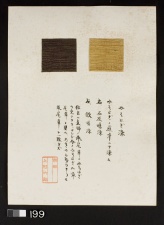Difference between revisions of "Misohagi (Loosestrife) - left (199 L)"
Jump to navigation
Jump to search
(username removed) |
(username removed) |
||
| Line 5: | Line 5: | ||
| 199 | | 199 | ||
|- | |- | ||
| − | ! scope="row"| | + | ! scope="row"|Uemura number / title |
| − | | | + | | ; "Haze-some 25" |
|- | |- | ||
! scope="row"|Folder location | ! scope="row"|Folder location | ||
| Line 41: | Line 41: | ||
| - | | - | ||
|- | |- | ||
| − | ! scope="row"| | + | ! scope="row"|Uemura's notes |
| − | | In past, Misogihagi (Lythrum anceps (Koehne) Makino) and Akinotamuraso (Salvia japonica Thub.) had been categorized as same plant as chinese | + | | In past, Misogihagi (Lythrum anceps (Koehne) Makino) and Akinotamuraso (Salvia japonica Thub.) had been categorized as same plant as chinese , but they were not. |
|- | |- | ||
| − | ! scope="row"| | + | ! scope="row"|Uemura's date |
| Kyoto | | Kyoto | ||
|} | |} | ||
| − | [[Category: | + | [[Category:Uemura dye archive]] |
Revision as of 07:18, 24 July 2013
| Museum number | 199 |
|---|---|
| Uemura number / title | ; "Haze-some 25" |
| Folder location | 3rd shelf |
| Sample location | left (199 L) |
| Fiber type | silk |
| Color | black |
| Dyestuff (Japanese common name) | みそはぎ : Misohagi |
| Dyestuff (botanical name) | Lythrum anceps (Koehne) Makino |
| Plant part | unspecified |
| Dyestuff extraction | boiled in water |
| Auxiliary agent in dye bath | - |
| Mordant | iron |
| Other auxiliary agent | - |
| Uemura's notes | In past, Misogihagi (Lythrum anceps (Koehne) Makino) and Akinotamuraso (Salvia japonica Thub.) had been categorized as same plant as chinese , but they were not. |
| Uemura's date | Kyoto |
